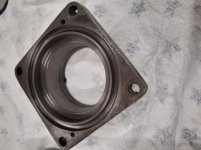I’m starting to use my fp3 cnc more and more for little jobs, just to get to know it better. The dialog 4 control is a nice control to use. The serial communication is also working, so I can download the jobs. Started to work at 50% feed and everything is working fine. I noticed that the lubrication of the ways was missing. So I spend a couple of days cleaning every valve and oil line.
Last week I was running a job with some fast G0 Z axis moves for the first time at 100% feed. Downwards worked fine, but upwards resulted in a horrible noise. After a couple of seconds the control stopped. I did some testing and fast moves work fine with a maximum of 60% feed. If I select a higher feed percentage, the Z axis stalls during fast upwards movements and the control goes down. I can use a G1 with maximum feed without any problem. There is no mechanical noise from the Z axis.
I found some topics on the forum which indicated that the tacho needed cleaning. I removed the covers, loosened the manual control and removed the top of the Z servo. This didn’t look very bad. I cleaned and de-greased it but without any result. I also re-calibrated the bosch servo driver. But this does not make a difference.
I also read that the axis are mechanically overload protected. The noise is really terrifying. But I can not differentiate if the overload kicks in because the table is moving badly, or the bosch servo driver is not very happy with the servo and tacho. I also loosened the key in the middle and some bolts at the back of the table to make sure the table could move freely. The problem remained.
To check the Z spindle I put some wood under the table and directed the table down. Once it reached the wood, I could hear the overload protection. Due to the very limited speed the noise was not very loud, but it sounded somehow familiar. I have loosened the Z servo and removed the belt. The belt seems fine. I can move the table upwards by turning the spindle by hand. The Z spindle and table are are moving freely.
At this point I suspect the overload protection of the Z axis. A bit strange because the table is empty and I removed the whole cover. There is not that much of weight to carry. Can it be that the acceleration of the servo is too much for the overload protection? Does anyone have experience in this area? Maybe some other options to check? Your help is much appreciated!
Regards, Rene.
Last week I was running a job with some fast G0 Z axis moves for the first time at 100% feed. Downwards worked fine, but upwards resulted in a horrible noise. After a couple of seconds the control stopped. I did some testing and fast moves work fine with a maximum of 60% feed. If I select a higher feed percentage, the Z axis stalls during fast upwards movements and the control goes down. I can use a G1 with maximum feed without any problem. There is no mechanical noise from the Z axis.
I found some topics on the forum which indicated that the tacho needed cleaning. I removed the covers, loosened the manual control and removed the top of the Z servo. This didn’t look very bad. I cleaned and de-greased it but without any result. I also re-calibrated the bosch servo driver. But this does not make a difference.
I also read that the axis are mechanically overload protected. The noise is really terrifying. But I can not differentiate if the overload kicks in because the table is moving badly, or the bosch servo driver is not very happy with the servo and tacho. I also loosened the key in the middle and some bolts at the back of the table to make sure the table could move freely. The problem remained.
To check the Z spindle I put some wood under the table and directed the table down. Once it reached the wood, I could hear the overload protection. Due to the very limited speed the noise was not very loud, but it sounded somehow familiar. I have loosened the Z servo and removed the belt. The belt seems fine. I can move the table upwards by turning the spindle by hand. The Z spindle and table are are moving freely.
At this point I suspect the overload protection of the Z axis. A bit strange because the table is empty and I removed the whole cover. There is not that much of weight to carry. Can it be that the acceleration of the servo is too much for the overload protection? Does anyone have experience in this area? Maybe some other options to check? Your help is much appreciated!
Regards, Rene.




